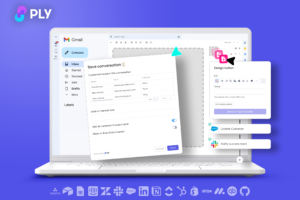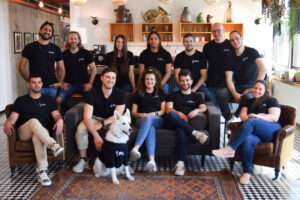Today’s fast-paced and cutthroat tech landscape made businesses constantly seek to automate processes and streamline workflows to increase productivity and efficiency. As a result, the demand for low/no-code tools has skyrocketed. These tools have made it easier than ever to build automation, tools, and databases, often without requiring any programming knowledge. However, in some cases, the rush to build new solutions can lead to overlooking the potential of existing ones.
Maximizing the potential of an existing apps is often a more efficient option than building a new one, from boosted productivity, optimized speed, and seamless onboarding, to effortless adoption. This is where Israel-based startup Ply comes in. The company recently came out of stealth to launch its no-code customization platform, allowing organizations to build custom internal features into the apps they already use. This platform empowers users to add contextual solutions into apps, from Gmail, Zendesk, and Salesforce, to HubSpot – all at scale.
Ply is built around small software components, or features, which enhance the functionality of existing applications. One example of a feature is add-ons, which can insert buttons and interfaces within applications and utilize data from the user’s current view, such as an email or a ticket. With add-ons, it is possible to incorporate Salesforce data into Gmail based on the sender of an email.
Another feature is notifications, which enables developers to not only specify when a notification is sent, but also create customized post-click functionality for approvals, feedback, and other contextual actions. Ply also provides command bar tools, customer portals, and other features that utilize existing applications.
Ply’s Contextual Nature
Co-Founders Yaniv Tross (CEO), Zohar Sakal-Glikman (COO), and Guy Schlider recognized the influx of applications and tools that aren’t utilized to their maximum capacity. Oftentimes, organizations would resort to building a new software application just to solve a specific problem. While this has been a norm that the industry has consistently navigated, the team at Ply knew that contextual solutions are far more effective. “Over the last decade, countless low/no-code tools have emerged to allow building automation, tools, and databases. While some use cases require a new dedicated tool, most of the time having a contextual solution is 10x more effective. It’s more productive, faster to create, easier to onboard to, and effortless to adopt. But mostly, it’s what users actually want,” said Yaniv. “Think about it this way, when a software company wants to solve a problem for its users, it doesn’t create an entire new product. It adds a feature where the problem is. Ply is making this the reality for ops and internal product teams too.”
Ply’s focus on context makes it an ideal platform for developing AI applications. Creating AI solutions that provide high value is challenging, particularly due to the need for context awareness. However, Ply makes it easy for organizations to create customized AI solutions that are contextually aware. In addition, the platform includes native integration with OpenAI, a prebuilt prompt interface, and other tools that enable organizations to leverage contextual AI.
Behind Ply’s Matrix Approach
Ply offers unique permissioning and security controls that allow enterprise customers to adopt fast without any hassle. The platform’s permission matrix approach enables IT teams to precisely define the level of freedom for builders, promoting innovation while reducing the risks associated with broad access. Furthermore, Ply’s Synced Groups feature makes it easy to manage permissions at scale by enabling admins to grant access to features based on permissions in the destination app. This is done by syncing the permission structure back to Ply. Furthermore, the company has been in a closed beta phase, collaborating with teams from both small businesses and larger enterprises.
“We’ve seen an interesting process with nearly all of our customers, regardless of their size. They start with simple hacks to eliminate copying and pasting like ‘send ticket to slack’, and within a few weeks, they’re building complex business logic into vendor apps – things like sales playbooks, employee onboarding, and legal approvals,” Tross concluded. “We started out building Ply for ops and IT, which are still our main customers, but we’ve quickly discovered that people in almost every role are building features. It’s an intuitive need – if you’ve ever said to yourself ‘I wish Gmail could do that thing’ then you get it. From developers to account executives and CSMs, everyone has an itch they want to scratch with Ply.”























